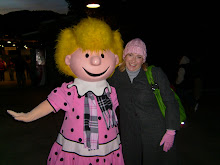What Nana wants, Nana gets. . . . and Nana wants to save copies of these Tech Tips on her desktop.
There are a couple of different options for saving an object on your desktop that will allow you to click directly to each tip. One requires use of your computer's memory, the other requires that you be online to access the actual pages.
Before we begin -- A note on keeping your desktop organized:
The first step is an optional one but is highly recommended. You should always create folders for anything you are saving or you will have a mess. Go to your desktop, right click in an empty space. From that menu, select "New" then select "Folder":
The result will be a folder icon on your desktop with a customizable name. Once the icon is there, just type out the name you want.. If you forget to name your folder, you can double click on the name and it will become editable and will look like this:
Once you have your folder, you are ready to save stuff to your desktop.
Option One: Saving a copy to your desktop
Open the copy of the tech tip you wish to save. Each posting has its own unique URL; make sure you are in the Tech Tip itself and not the list of all Tech Tips. (For instance, you want to see the URL as "http://techtips4nana.blogspot.com/2009/01/how-do-i-share-this-with-my-friends.html" versus "http://techtips4nana.blogspot.com/". Once you are in your page, use your browser tool bar and click on "File" then "Save As". It should look like this:
You will then get a new window, pre-populated with the right option for saving your files. It will also use the page title as the document name unless you make a change to the "File Name" field.
Make sure you save to your folder because the program is going to save an additional folder with all pieces of the page your computer needs to be able to see this offline. In the example above, you can see that there are two items in the folder. The one with "htm" on the end is the file you will double click when you want to see the page again. The other folder is all of the files your computer needs for you to see the page properly when you aren't connected to the internet.
Option Two: Saving a shortcut to the article to your desktop
This option requires you to be connected to the internet when you access the files. Just like the first option, you are going to use your browser toolbar to save a shortcut. Click on "File", select "Send" and click on "Shortcut to Desktop".
You will end up with an icon on your desktop that looks like this:
In this example, you can see that when I rolled over the file, I get a yellow description overlay that describes where the shortcut will direct. Also, depending on the version of your tools, you may see a different image when you save the shortcut.
Do not be alarmed . . . this is a "feature" of the programs telling you where the page lives. In this example, you can see the logo for Blogger . . . this is the free blogging site I use to post your Tech Tips. Regardless of the icon created, to get this into that folder you created, you will need to drag and drop the icon into your new folder. Here's what that looks like in compared to the other files we saved:
All you have to do is double click that icon and your browser will launch to that Tech Tip.
Tip of the Day:
Another option for finding your tech tip is to use the tools within the blog. To the right of this Tip are two things you can use to find old tips.
1) the Blog archive will list out all every Tip I have created for you in reverse chronological order
2) the type in a keyword into the search box and you can find the postings that mention those words. Try it out . . . type in "facebook" and hit search. Let me know what you find!
















 The resulting list is all houses in or near Boise that have 6 or more bedrooms.
The resulting list is all houses in or near Boise that have 6 or more bedrooms.
 *A good rule of thumb for internet searching is to type in keywords you might look for in a card catalogue if you were searching at a library.
*A good rule of thumb for internet searching is to type in keywords you might look for in a card catalogue if you were searching at a library.
 lbar of the browser. The what of the hmmmmmmmm?
lbar of the browser. The what of the hmmmmmmmm? 


